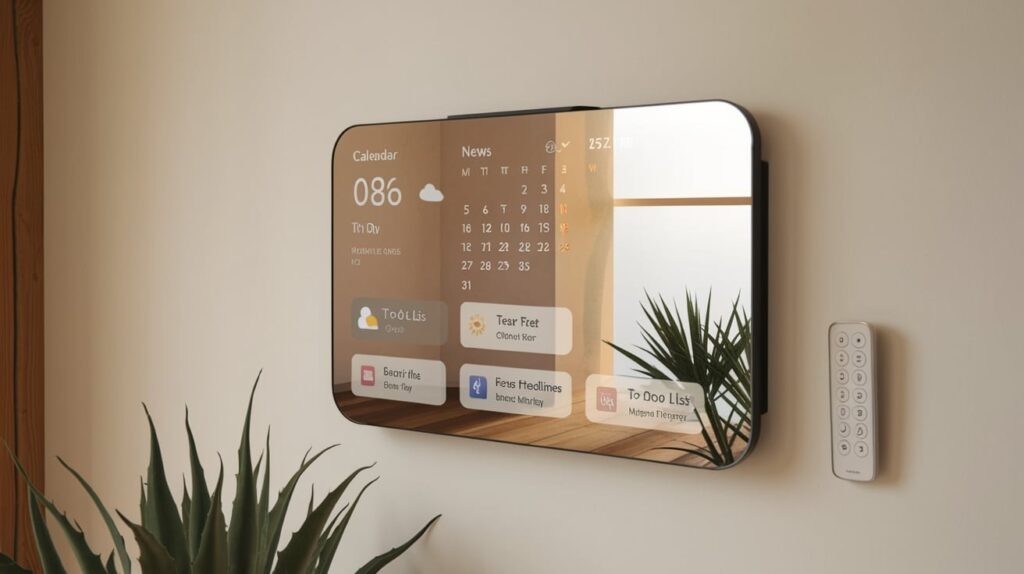Setting Up Your Smart Mirror Display
The first step in customizing your smart mirror is setting it up correctly. Ensure all hardware components, including the mirror panel, display screen, and frame, are securely installed. Most smart mirrors come with pre-installed software, but you may need to connect it to your network or download updates for the latest features.
Connecting to Wi-Fi
To access the features of a smart mirror display, ensure your device is connected to a stable Wi-Fi network. Navigate to the settings menu, locate the connectivity option, and follow the prompts to join your preferred network. A strong connection is crucial for seamless functionality, such as displaying real-time information and accessing online integrations.
Pairing with Smart Devices
Modern smart mirrors are designed to sync with various devices like smartphones, tablets, and smart home systems. Enable Bluetooth or the specific pairing mode on your digital smart mirror to establish a connection with your devices. This feature allows for greater control and easier customization through dedicated apps or voice commands.
Customizing Display Widgets and Layouts
Customizing the widgets and layouts on your smart interactive mirror ensures that the information displayed aligns with your daily needs. Follow these steps to organize your display effectively.
Selecting Relevant Widgets
Most smart mirrors offer a variety of widgets, such as clock, weather forecast, news updates, and fitness trackers. Open the settings menu and navigate to the widget selection panel. Choose the widgets you use frequently and remove unnecessary ones to declutter the screen.
Adjusting Widget Positions
To personalize the look of your smart mirror display, arrange widgets in a way that aligns with your preferences. Most systems allow users to drag and drop widgets within the interface. Ensure essential information is placed in prominent locations for easy visibility.
Configuring Appearance Settings
Many smart mirrors let users customize the visual style of their displays. Adjust the theme, font style, and background colors through the appearance menu. Opt for settings that blend seamlessly with your space while maintaining readability.
Fine-Tuning Smart Mirror Touch Screen Features
A smart mirror touch screen enhances interactivity, enabling users to access features through simple gestures. Customizing touch screen settings can further improve your experience.
Calibrating the Touch Screen
Access the settings menu to calibrate the touch sensitivity of your smart mirror. Proper calibration ensures that the screen responds accurately to your inputs. If you encounter delays or inaccuracies, recalibrate for optimal performance.
Managing Gesture Controls
Many smart mirrors support gesture controls for hands-free interaction. Enable or disable this feature based on your preferences, and set up specific gestures to perform tasks like switching widgets, adjusting brightness, or scrolling through information.
Adding User Profiles
For households with multiple users, setting up individual profiles on the smart mirror touch screen is a practical option. Each profile can have its own customized widgets, layouts, and preferences, ensuring a tailored experience for everyone.
Adjusting Display Brightness and Power Settings
To optimize the performance and energy efficiency of your smart mirror, focus on brightness and power settings.
Modifying Brightness Levels
Brightness adjustments can make the digital smart mirror display more comfortable to use in different lighting conditions. Access the display settings and either set the brightness manually or enable an automatic mode that adjusts based on ambient light.
Scheduling Power Modes
Set power schedules to turn the smart mirror on and off automatically. This feature helps conserve energy and ensures the mirror is active only when needed.
Integrating Third-Party Applications
Integrating third-party apps with your smart interactive mirror can expand its capabilities significantly.
Popular Applications for Smart Mirrors
Some commonly used apps include fitness trackers, to-do lists, and streaming services. Install compatible apps through the smart mirror’s built-in marketplace or directly from the connected device.
Managing Notifications
Ensure notifications from synced devices are filtered to avoid unnecessary clutter on the display. Choose which notifications to display and adjust the timing to align with your preferences.
Keeping Software Updated
Regular software updates are essential to keep your digital smart mirror running smoothly and equipped with the latest features. Enable automatic updates or check for updates manually through the settings menu.
Backing Up Preferences
Before applying updates, back up your customized settings to avoid losing them. Most smart mirrors have a backup option within the system menu.
Future-Proofing Your Smart Mirror
To stay ahead in 2024, consider how your smart mirror can adapt to future needs. Investing time in initial customization will ensure a seamless experience over time.
Multi-Touch Display Capabilities
For advanced functionality, explore the multi touch display features. This technology enables simultaneous inputs, ideal for interactive applications like design tools, educational interfaces, or collaborative tasks.
By following these customization steps, you can unlock the full potential of your smart mirror and integrate it seamlessly into your daily routine.






